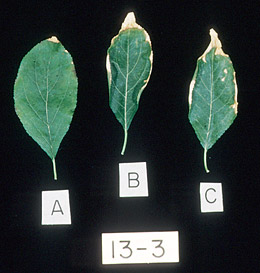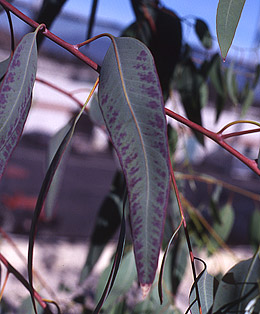Salinity Management Guide

Leaves of plum trees damaged by sodium
Fundamentals
Toxicity of specific ions — A brief introduction
The total salinity of irrigation water is an important consideration for any landscape project. If water containing too much salt is applied during irrigation, salt tends to build up in the soil, reducing the amount of water available to plants.
Individual ionic constituents are also an important consideration. Three constituents, in particular, have considerable potential to damage or otherwise adversely affect ornamental plants: sodium ion (Na+) , chloride ion (Cl-), and boron (B).
Sodium ion
The roots of a plant can absorb sodium ion and transport it to the plant's leaves. From there, the sodium has nowhere else to go and typically accumulates. For some species, this accumulation of sodium causes no obvious symptoms. For others, especially such woody plants as azaleas, camellias, roses, and stone fruits, necrosis of leaves is a common result. Typically, this manifests as marginal scorching of the leaves or abscission (dropping) of the leaves.
Many species of plants also absorb sodium directly through their leaves, from water present on the leaves (resulting either from rainfall or from sprinkled irrigation water). If a plant absorbs more sodium by this pathway than it can tolerate, abscission of leaves is a common result.

Leaves of plum tree damaged by chloride
Chloride ion
Plants can absorb chloride via their roots and store it in their leaves. When this happens, depending on the plant's sensitivity to chloride, toxic symptoms may appear. Those symptoms are similar to the ones seen when sodium becomes a problem: scorching or abscission of leaves. Foliar absorption of chloride is also common. It may, for sensitive plants, result in the abscission of leaves.
Boron
Boron is quite toxic to many plants, even at low concentrations. As little as 0.8 mg/L can result in leaf margin necrosis.
Plants absorb boron through their roots and store it in their leaves. Boron is not normally absorbed directly via the leaves, however. Consequently, irrigating a boron-sensitive plant with sprinklers is no more hazardous to the plant than are furrow irrigation, drip irrigation, or other methods that tend not to spray or mist water onto the plant's leaves.

Boron-damaged (spotted) eucalyptus leaves
Specific ions in recycled water
Recycled water typically has higher concentrations of sodium ion, chloride, and boron than the water from which it was made. This is especially true when the recycled water originates from a community where many houses have been equipped with salt-based water softeners and where residents frequently use cleansers containing boron.
Prior to irrigating a landscape with recycled water, it's wise to determine or estimate the concentrations of sodium ion, chloride, and boron in the water. Very low concentrations of sodium, chloride, and boron actually can be beneficial, because they help plants to grow. When those concentrations are exceeded, however, sodium ion, chloride, and boron can become a problem for plants, as outlined in the foregoing paragraphs.
Some types of plants can tolerate higher concentrations of sodium, chloride, and boron than others. For instance, trees and shrubs, which are longer-lived than herbaceous plants, have more time in which to accumulate ions and thus tend to be more severely affected than annual plants. As another example, consider turf grasses. Most of them tolerate high Na+ levels and much higher Cl- levels. Boron tolerance is relatively good, too, compared to other types of plants.
Chemical tolerances vary by plant species as well as by plant type. That is why it is vital to know the particular tolerances of plants being irrigated.
| « Previous page | Next page » |